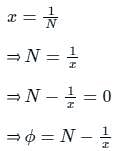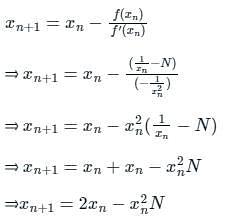Civil Engineering (CE) Exam > Civil Engineering (CE) Questions > The Newton-Raphson method is to be used to de...
Start Learning for Free
The Newton-Raphson method is to be used to determine the reciprocal of the number x = 4. If we start with the initial guess 0.20 then after the first iteration the reciprocal is
- a)0.23
- b)0.24
- c)0.25
- d)0.26
Correct answer is option 'B'. Can you explain this answer?
| FREE This question is part of | Download PDF Attempt this Test |
Most Upvoted Answer
The Newton-Raphson method is to be used to determine the reciprocal of...
Newton-Raphson Method:
The Newton-Raphson method is an iterative numerical method used to find the roots of a given equation. It is based on the principle of linear approximation and uses the tangent line to iteratively approach the root.
Reciprocal of a Number:
The reciprocal of a number x is defined as 1/x. In this case, we are tasked with finding the reciprocal of x = 4.
Initial Guess:
In order to apply the Newton-Raphson method, we need to start with an initial guess. In this case, the initial guess is given as 0.20.
Iteration Process:
The Newton-Raphson method involves iteratively improving the initial guess until an acceptable level of accuracy is achieved. Let's go through the iteration process step by step:
Step 1:
We start with the initial guess: x0 = 0.20
Step 2:
The equation that we want to find the root of is: f(x) = 1/x - 4 = 0
Step 3:
To apply the Newton-Raphson method, we need to find the derivative of f(x) with respect to x. The derivative of 1/x is -1/x^2.
Step 4:
We can now apply the Newton-Raphson formula to update the guess:
x1 = x0 - (f(x0) / f'(x0))
= 0.20 - ((1/0.20 - 4) / (-1/0.20^2))
= 0.20 - ((1/0.20 - 4) / (-1/0.04))
= 0.20 - ((5 - 4) / (-25))
= 0.20 + (1 / 25)
= 0.20 + 0.04
= 0.24
Step 5:
We have now completed the first iteration and obtained a new guess x1 = 0.24.
Conclusion:
After the first iteration of the Newton-Raphson method, the reciprocal of x = 4 is approximately 0.24. Therefore, the correct answer is option 'B'.
The Newton-Raphson method is an iterative numerical method used to find the roots of a given equation. It is based on the principle of linear approximation and uses the tangent line to iteratively approach the root.
Reciprocal of a Number:
The reciprocal of a number x is defined as 1/x. In this case, we are tasked with finding the reciprocal of x = 4.
Initial Guess:
In order to apply the Newton-Raphson method, we need to start with an initial guess. In this case, the initial guess is given as 0.20.
Iteration Process:
The Newton-Raphson method involves iteratively improving the initial guess until an acceptable level of accuracy is achieved. Let's go through the iteration process step by step:
Step 1:
We start with the initial guess: x0 = 0.20
Step 2:
The equation that we want to find the root of is: f(x) = 1/x - 4 = 0
Step 3:
To apply the Newton-Raphson method, we need to find the derivative of f(x) with respect to x. The derivative of 1/x is -1/x^2.
Step 4:
We can now apply the Newton-Raphson formula to update the guess:
x1 = x0 - (f(x0) / f'(x0))
= 0.20 - ((1/0.20 - 4) / (-1/0.20^2))
= 0.20 - ((1/0.20 - 4) / (-1/0.04))
= 0.20 - ((5 - 4) / (-25))
= 0.20 + (1 / 25)
= 0.20 + 0.04
= 0.24
Step 5:
We have now completed the first iteration and obtained a new guess x1 = 0.24.
Conclusion:
After the first iteration of the Newton-Raphson method, the reciprocal of x = 4 is approximately 0.24. Therefore, the correct answer is option 'B'.
Free Test
FREE
| Start Free Test |
Community Answer
The Newton-Raphson method is to be used to determine the reciprocal of...
According to the Newton-Rapson method we have;

CALCULATION:
As we know;

Now,

Now putting all the values we have;
xn+1 = 2 × 0.20 − 0.202 × 4
⇒ xn+1 = 0.24
Hence option (2) is the correct answer.

CALCULATION:
As we know;

Now,

Now putting all the values we have;
xn+1 = 2 × 0.20 − 0.202 × 4
⇒ xn+1 = 0.24
Hence option (2) is the correct answer.
Attention Civil Engineering (CE) Students!
To make sure you are not studying endlessly, EduRev has designed Civil Engineering (CE) study material, with Structured Courses, Videos, & Test Series. Plus get personalized analysis, doubt solving and improvement plans to achieve a great score in Civil Engineering (CE).

|
Explore Courses for Civil Engineering (CE) exam
|

|
Similar Civil Engineering (CE) Doubts
The Newton-Raphson method is to be used to determine the reciprocal of the number x = 4. If we start with the initial guess 0.20 then after the first iteration the reciprocal isa)0.23b)0.24c)0.25d)0.26Correct answer is option 'B'. Can you explain this answer?
Question Description
The Newton-Raphson method is to be used to determine the reciprocal of the number x = 4. If we start with the initial guess 0.20 then after the first iteration the reciprocal isa)0.23b)0.24c)0.25d)0.26Correct answer is option 'B'. Can you explain this answer? for Civil Engineering (CE) 2024 is part of Civil Engineering (CE) preparation. The Question and answers have been prepared according to the Civil Engineering (CE) exam syllabus. Information about The Newton-Raphson method is to be used to determine the reciprocal of the number x = 4. If we start with the initial guess 0.20 then after the first iteration the reciprocal isa)0.23b)0.24c)0.25d)0.26Correct answer is option 'B'. Can you explain this answer? covers all topics & solutions for Civil Engineering (CE) 2024 Exam. Find important definitions, questions, meanings, examples, exercises and tests below for The Newton-Raphson method is to be used to determine the reciprocal of the number x = 4. If we start with the initial guess 0.20 then after the first iteration the reciprocal isa)0.23b)0.24c)0.25d)0.26Correct answer is option 'B'. Can you explain this answer?.
The Newton-Raphson method is to be used to determine the reciprocal of the number x = 4. If we start with the initial guess 0.20 then after the first iteration the reciprocal isa)0.23b)0.24c)0.25d)0.26Correct answer is option 'B'. Can you explain this answer? for Civil Engineering (CE) 2024 is part of Civil Engineering (CE) preparation. The Question and answers have been prepared according to the Civil Engineering (CE) exam syllabus. Information about The Newton-Raphson method is to be used to determine the reciprocal of the number x = 4. If we start with the initial guess 0.20 then after the first iteration the reciprocal isa)0.23b)0.24c)0.25d)0.26Correct answer is option 'B'. Can you explain this answer? covers all topics & solutions for Civil Engineering (CE) 2024 Exam. Find important definitions, questions, meanings, examples, exercises and tests below for The Newton-Raphson method is to be used to determine the reciprocal of the number x = 4. If we start with the initial guess 0.20 then after the first iteration the reciprocal isa)0.23b)0.24c)0.25d)0.26Correct answer is option 'B'. Can you explain this answer?.
Solutions for The Newton-Raphson method is to be used to determine the reciprocal of the number x = 4. If we start with the initial guess 0.20 then after the first iteration the reciprocal isa)0.23b)0.24c)0.25d)0.26Correct answer is option 'B'. Can you explain this answer? in English & in Hindi are available as part of our courses for Civil Engineering (CE).
Download more important topics, notes, lectures and mock test series for Civil Engineering (CE) Exam by signing up for free.
Here you can find the meaning of The Newton-Raphson method is to be used to determine the reciprocal of the number x = 4. If we start with the initial guess 0.20 then after the first iteration the reciprocal isa)0.23b)0.24c)0.25d)0.26Correct answer is option 'B'. Can you explain this answer? defined & explained in the simplest way possible. Besides giving the explanation of
The Newton-Raphson method is to be used to determine the reciprocal of the number x = 4. If we start with the initial guess 0.20 then after the first iteration the reciprocal isa)0.23b)0.24c)0.25d)0.26Correct answer is option 'B'. Can you explain this answer?, a detailed solution for The Newton-Raphson method is to be used to determine the reciprocal of the number x = 4. If we start with the initial guess 0.20 then after the first iteration the reciprocal isa)0.23b)0.24c)0.25d)0.26Correct answer is option 'B'. Can you explain this answer? has been provided alongside types of The Newton-Raphson method is to be used to determine the reciprocal of the number x = 4. If we start with the initial guess 0.20 then after the first iteration the reciprocal isa)0.23b)0.24c)0.25d)0.26Correct answer is option 'B'. Can you explain this answer? theory, EduRev gives you an
ample number of questions to practice The Newton-Raphson method is to be used to determine the reciprocal of the number x = 4. If we start with the initial guess 0.20 then after the first iteration the reciprocal isa)0.23b)0.24c)0.25d)0.26Correct answer is option 'B'. Can you explain this answer? tests, examples and also practice Civil Engineering (CE) tests.

|
Explore Courses for Civil Engineering (CE) exam
|

|
Suggested Free Tests
Signup for Free!
Signup to see your scores go up within 7 days! Learn & Practice with 1000+ FREE Notes, Videos & Tests.
























